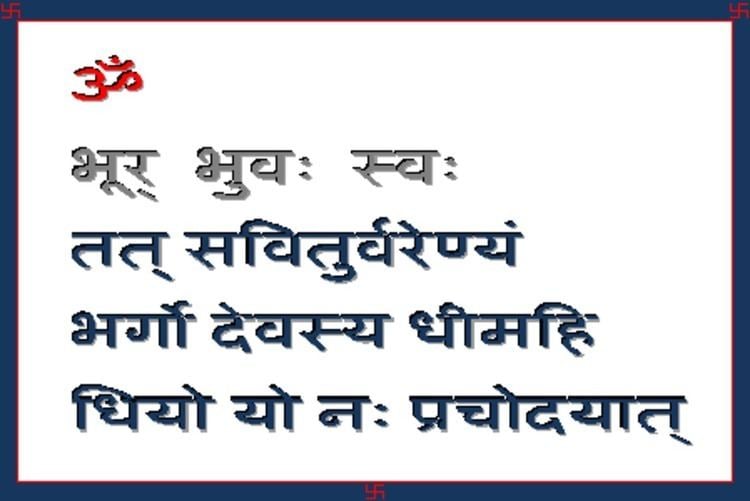 | ||
The Gāyatrī Mantra, also known as the Sāvitrī mantra, is a highly revered mantra from the Rig Veda (Mandala 3.62.10), dedicated to Savitr, the Sun deity. Gāyatrī is the name of the Vedic meter in which the verse is composed. Its recitation is traditionally preceded by oṃ and the formula bhūr bhuvaḥ svaḥ, known as the mahāvyāhṛti, or "great (mystical) utterance".
Contents
- Text
- Dedication
- Translations
- Vedic and Vedantic literature
- Buddhist corpus
- Upanayana ceremony
- Mantra recitation
- Brahmo Samaj
- Hindu revivalism
- Popular culture
- References
The Gayatri mantra is cited widely in Vedic and post-Vedic texts, such as the mantra listings of the Śrauta liturgy, and classical Hindu texts such as the Bhagavad Gita, Harivamsa, and Manusmṛti. It is the subject of esoteric treatment and explanation in some major Upanishads, and is also referred to in the Buddhist Pali Canon.
The mantra is an important part of the upanayana ceremony for young males in Hinduism, and has long been recited by dvija men as part of their daily rituals. Modern Hindu reform movements spread the practice of the mantra to include women and all castes and its use is now very widespread.
Text
The main mantra appears in the hymn RV 3.62.10. During its recitation, the hymn is preceded by oṃ (ॐ) and the formula bhūr bhuvaḥ svaḥ (भूर् भुवः स्वः). This prefixing of the mantra proper is described in the Taittiriya Aranyaka (2.11.1-8), which states that it should be chanted with the syllable oṃ, followed by the three Vyahrtis and the Gayatri verse. Whereas in principle the gāyatrī mantra specifies three pādas of eight syllables each, the text of the verse as preserved in the Samhita is one short, seven instead of eight. Metrical restoration would emend the attested tri-syllabic vareṇyaṃ with a tetra-syllabic vareṇiyaṃ.
The Gayatri mantra is, in Devanagari:
ॐ भूर्भुवः स्वः ।तत्स॑वि॒तुर्वरेण्यं॒भर्गो॑ दे॒वस्य॑ धीमहि ।धियो॒ यो नः॑ प्रचो॒दया॑त् ॥In IAST:
om bhūr bhuvaḥ svaḥtát savitúr váreṇ(i)yaṃbhárgo devásya dhīmahidhíyo yó naḥ prachodayāt– Rigveda 3.62.10Dedication
The Gāyatrī Mantra is dedicated to Savitr, a Vedic Sun deity.
Translations
The Gayatri Mantra has been translated in many ways. Quite literal translations include:
More interpretative translations include:
Vedic and Vedantic literature
The Gayatri mantra is cited widely in Vedic and post-Vedic texts, such as the mantra listings of the Śrauta liturgy, and cited several times in the Brahmanas and the Srauta-sutras. It is also cited in a number of grhyasutras, mostly in connection with the upanayana ceremony in which it has a significant role.
The Gayatri mantra is the subject of esoteric treatment and explanation in some major Upanishads, including Mukhya Upanishads such as the Brihadaranyaka Upanishad, the Shvetashvatara Upanishad and the Maitrayaniya Upanishad; as well as other well-known works such as the Jaiminiya Upanishad Brahmana. The text also appears in minor Upanishads, such as the Surya Upanishad.
The Gayatri mantra is the apparent inspiration for derivative "gāyatrī" stanzas dedicated to other deities. Those derivations are patterned on the formula vidmahe - dhīmahi - pracodayāt", and have been interpolated into some recensions of the Shatarudriya litany. Gāyatrīs of this form are also found in the Mahanarayana Upanishad.
The Gayatri mantra is also repeated and cited widely in classical Hindu texts such as the Bhagavad Gita, Harivamsa, and Manusmṛti.
Buddhist corpus
In Samyutta Nikaya 111, Majjhima Nikaya 92 and Vinaya i 246 of the Pali Canon, the Buddha refers to the Agnihotra as the foremost sacrifice and the Gayatri mantra as the foremost meter:
aggihuttamukhā yaññā sāvittī chandaso mukham.
Sacrifices have the agnihotra as foremost; of meter the foremost is the Sāvitrī.
Upanayana ceremony
Imparting the Gayatri mantra to young Sanatan men is an important part of the traditional upanayana ceremony, which marks the beginning of study of the Vedas. Sarvepalli Radhakrishnan described this as the essence of the ceremony, which is sometimes called "Gayatri diksha", i.e. initiation into the Gayatri mantra. However, traditionally, the stanza RV.3.62.10 is imparted only to Brahmin boys. Other Gayatri verses are used in the upanayana ceremony for non-Brahmins: RV.1.35.2, in the tristubh meter, for a kshatriya and either RV.1.35.9 or RV.4.40.5 in the jagati meter for a Vaishya.
Mantra-recitation
Gayatri japa is used as a method of prāyaścitta, instrument of Tantric practice. It is believed by practitioners that reciting the mantra bestows wisdom and enlightenment, through the vehicle of the Sun (Savitr), who represents the source and inspiration of the universe.
Brahmo Samaj
In 1827 Ram Mohan Roy published a dissertation on the Gayatri mantra that analysed it in the context of various Upanishads. Roy prescribed a Brahmin to always pronounce om at the beginning and end of the Gayatri mantra. From 1830, the Gayatri mantra was used for private devotion of Brahmos. In 1843, the First Covenant of Brahmo Samaj required Gayatri mantra for Divine Worship. From 1848-1850 with the rejection of Vedas, the Adi Dharm Brahmins use the Gayatri mantra in their private devotions.
Hindu revivalism
In the later 19th century, Hindu reform movements spread the chanting of the Gayatri mantra. In 1898 for example, Swami Vivekananda claimed that, according to the Vedas and the Bhagavad Gita, a person became Brahmin through learning from his Guru, and not because of birth. He administered the sacred thread ceremony and the Gayatri mantra to non-Brahmins in Ramakrishna Mission. This Hindu mantra has been popularized to the masses, outside of Brahminic culture through pendants, audio recordings and mock scrolls. Various Gayatri yajñas organised by All World Gayatri Pariwar at small and large scales in late twentieth century also helped spread Gayatri mantra to the mass.
Popular culture
A version of the Gayatri mantra is featured in the opening theme song of the TV series Battlestar Galactica (2004). A variation on the William Quan Judge translation is also used as the introduction to Kate Bush's song "Lily" on her 1993 album, The Red Shoes.
